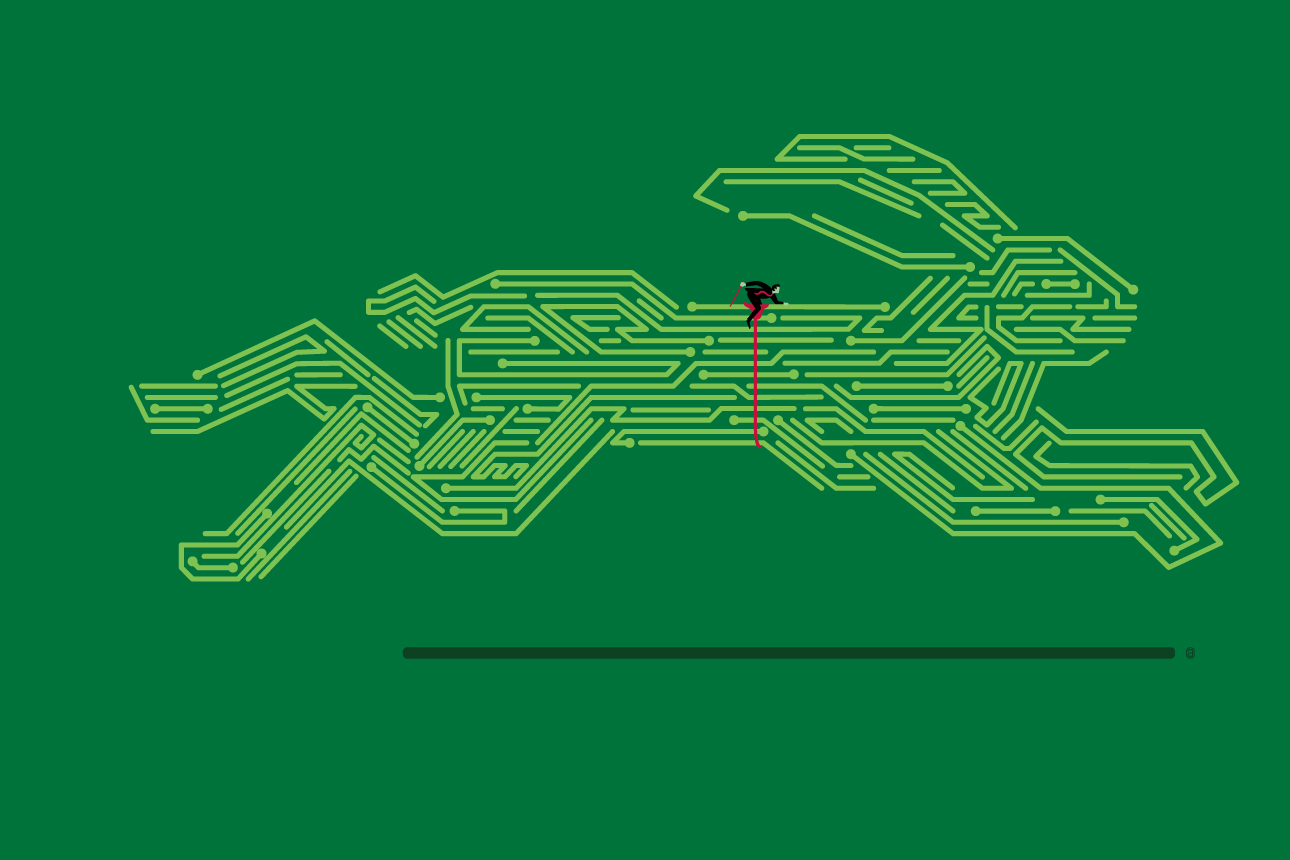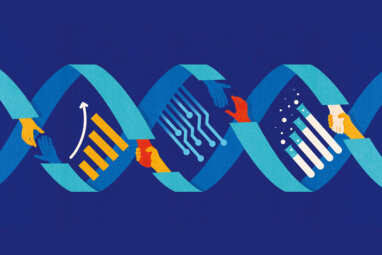How Maker Tools Can Accelerate Ideation
Forget traditional brainstorming — tools used for rapid prototyping can speed product development when used for idea generation.
Topics
Frontiers

Image courtesy of Aad Goudappel/theispot.com
Innovators face tremendous time pressures today, whether they are tackling urgent issues such as public health and climate change or designing new products to stay ahead in a fast-moving competitive market. To meet the challenge, companies are investing in a number of technologies that accelerate innovation, but for many, the process is still frustratingly slow. What should organizations do? Our short answer: Do not use accelerating technologies only for rapid prototyping; use them much earlier and differently, for rapid ideating.
In recent years, a new group of “accelerating technologies” such as 3D printers and Arduino and Raspberry Pi electronics have helped to significantly speed product development. 3D printing is used to quickly produce physical objects using layering methods guided by digital input files, and it has revolutionized the ability to prototype. Developers use tiny, affordable single-board Arduino and Raspberry Pi computers to build a wide variety of applications and devices. These technologies have largely been put to work at the rapid prototyping stage.1 But a study we conducted on accelerating innovation reveals that they provide even more accelerating power when teams use them differently and much earlier, for ideation.
We conducted an in-depth field study of accelerating innovation for assistive technologies in maker spaces in the U.S. (with Lior Zalmanson of Tel Aviv University).2 In our study, teams aimed to solve real-world assistive technology challenges, such as how to operate an elevator with voice or how to enable hearing-impaired individuals to “see” sounds in order to safely cross streets. This kind of innovation usually takes weeks or months, but these teams had just 72 hours to build new, working products and hand them over to anticipating users.
All participants were given these ambitious goals, faced the same time pressure, and had access to the same cutting-edge accelerating technologies, including 3D printers, Arduino and Raspberry Pi electronics, advanced laser cutters, and other maker-oriented gizmos like motors, carpentry tools, and welding equipment. None of the participants knew one another entering the challenge, and they quickly created ad hoc teams. We expected this to be a hard challenge; based on previous research on time-pressured innovation, most of them could be expected to fail, given that creativity often dies under time pressure.3 However, multiple teams were able to develop working new products in only 72 hours, so we looked more closely at how they did it.
We carefully studied the process of each team, hour by hour. Many teams followed widely accepted rapid prototyping best practices, developing a clearly defined idea first and then quickly creating a prototype to bring that idea to life. To develop their idea, these teams started with the familiar brainstorming discussions, whiteboard sketches, and a joint team effort to agree upon the desired prototype’s specific materials, mechanisms, and measurements. They simply pushed to do all of that much faster. Once they reached clarity on the desired product design, they quickly divided up the work and used the accelerating technologies to create their prototype. These teams were well organized and synchronized. And yet, at the end of the 72 hours, they were unable to produce functional devices and were deeply frustrated.
The teams that were able to create a working product in only 72 hours used the same accelerating technologies, but in a different way. Instead of first brainstorming their ideas, agreeing on what approach to pursue, and then using the accelerating technologies to prototype, these teams used the technologies to come up with the ideas themselves. We describe the way they used accelerating technologies for the ideation process as rapid ideating. In essence, they were able to use the accelerating technologies to guide their creative thinking in order to generate and experiment with multiple new possibilities rather than first choosing one to focus on.
Instead of engaging in traditional brainstorming sessions, the rapid ideating teams quickly rallied around a rough outline of a possible direction — a high-level sketch that was not clear or as highly specified as what the rapid prototyping teams developed. For instance, one rapid ideating team scribbled just a few key phrases on a sticky note to guide their work. They then immediately divided up to work as individuals or sub-teams, fired up their 3D printers, and started the rapid ideating. Meanwhile, on a similar challenge, a rapid prototyping team was using whiteboards to produce detailed drawings that included precise measurements (the design’s dimensions, how the components would fit together, and what kind of motor and power source would be required). The rapid ideating teams, however, were already experimenting: After multiple iterations, they returned to their teammates to share potential emerging design paths and began converging on a design and transitioning to the prototyping stage. The ability to rapidly ideate with accelerating technologies gave them a remarkable advantage.
Experimentation and Agility Under Time Pressure
We all know that experimentation is important, but when we are under intense time pressure, we often abandon that approach.4 Instead, time pressure and stress increase the desire for a sense of control and a clear, well-organized work process. However, we saw that rapid ideating enabled teams to experiment even under time pressure. Those teams experimented intensely from the very start in order to explore and pursue multiple product design paths simultaneously. Though it can be difficult and risky to maintain an experimental approach under time constraints, the use of accelerating technologies made it possible, despite the normal inclination to reduce ambiguity under time pressure.
This crucial advantage of rapid ideation for accelerating innovation was evident as the clock ran down and teams faced unexpected challenges. Inevitably, as in all new product development processes, all of the teams faced technical challenges and failures that called into question the viability of their respective approaches. Rapid prototyping teams persisted in iterating and tweaking their original, agreed-upon solution design; their brainstorming approach strengthened their commitment to it. Rapid ideating teams demonstrated far greater flexibility and agility, even under intense time pressure. These teams quickly adapted and pivoted, since they were simultaneously using the accelerating technologies to experiment along multiple diverse solution paths. The hyper-experimentation and fast pivoting that rapid ideating provides are exactly what is needed for accelerating innovation.
Ideation traditionally takes place through team discussion, which is very hard to speed up without causing problems in team dynamics or forcing premature closure on an idea. While rapid ideating teams avoided these traditional team brainstorming challenges, their approach came at a price. The rapid ideating teams were messier and less coordinated, and their teamwork was more difficult. Since these teams did not prioritize clarity and consensus upfront, they faced multiple challenging moments of conflict or misalignment. For instance, without a clearly defined path guiding their separate work activities, teammates often discovered that a component they had been working on was unusable and did not fit within the emerging design path, or that another teammate was working on something very similar. Over time, these teams developed an adaptive type of coordination that allowed them to swiftly update and nudge one another toward a common path while preserving the benefits of their experimental and divergent approach.
Rapid ideation allows us to break free from traditional brainstorming approaches that prioritize reaching consensus around a clearly defined and agreed-upon idea before moving forward. These approaches fail under extreme time pressure and can be seen as relics of a time when experimentation was costly and time-consuming. Rather than using accelerating technologies to speed the traditional process, we need to reimagine how we innovate and change our process to truly unleash the power of these technologies — and be better positioned to address 21st century challenges.
References (4)
1. R.L. Martin, “The Unexpected Benefits of Rapid Prototyping,” Harvard Business Review, Feb. 11, 2014, https://hbr.org.
2. H. Lifshitz-Assaf, S. Lebovitz, and L. Zalmanson, “Minimal and Adaptive Coordination: How Hackathons’ Projects Accelerate Innovation Without Killing It,” Academy of Management Journal 64, no. 3 (June 2021): 684-715.








